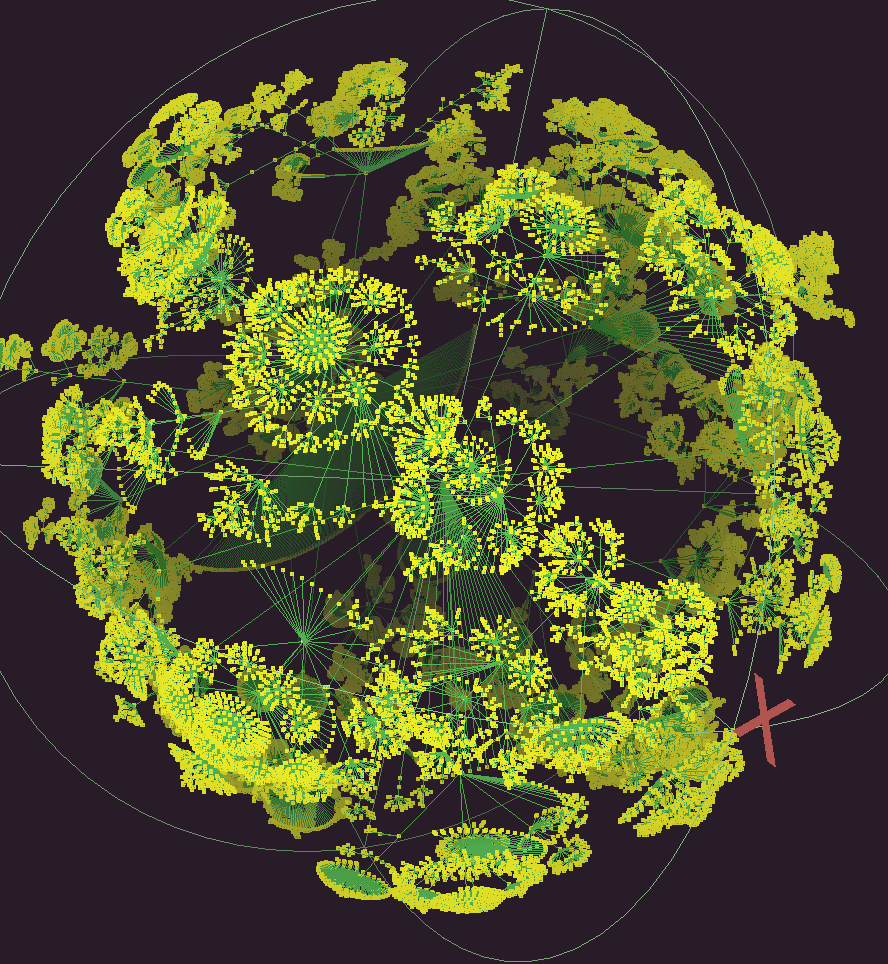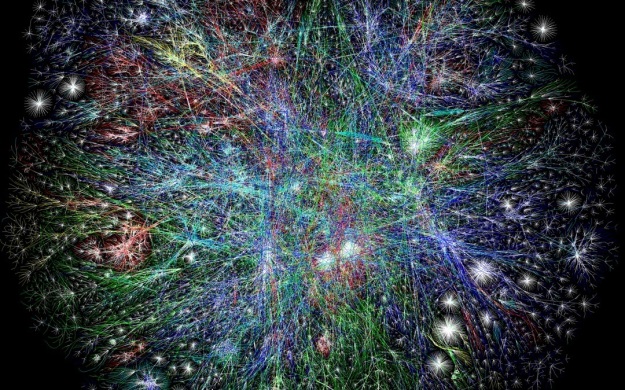‘A rhizome has no beginning or end; it is always in the middle, between things, interbeing, intermezzo. The tree is filiation, but the rhizome is alliance, uniquely alliance.’ (ATP, 25)
The internet is a strange and complex thing. Wherever I am in cyberspace, or wherever I could potentially be, I’m always virtually connected to any, and every, other point in cyberspace. All I need to do is enter a URL into my search bar or embed another URL into my website and a new connection is made amongst the billions of other connections already present. Any individual page on the modern internet is only a few clicks away from any other page. The structure of the internet is inherently non-linear.
In their magnum opus, A Thousand Plateuas, Gilles Deleuze and Felix Guattari painted a vast, non-linear, decentralised portrait of knowledge that would form the basis, and the underlying (anti-)structure of the book. They termed this ‘The Rhizome’. I aim to show how Deleuze and Guattari’s insights in the first chapter of A Thousand Plateaus (ATP) laid the groundwork for a whole new world view, one which is being actualised by the modern internet and the World Wide Web.
Rhizome
The idea of the rhizome is a structural metaphor taken from biological field of botany. It describes an underground mass of continuously growing horizontal stems or roots which extend lateral shoots at certain intervals in order to grow and establish connections with other shoots. There is no hierarchical structure to the growth of the rhizome. It doesn’t function in the same way as an arborescent ‘genealogy tree’ for example, where each point can only be connected along a strict, one directional, vertical line. A normal non-rhizomatic root grows down into the earth, dovetailing and forking from it’s initial base trunk; none of the points at the bottom will reconnect to the top other than through a one directional, vertical tracing.
One crucially important aspect of the rhizome as a metaphor for knowledge is that each and any point of the rhizome can be connected to any other at any given time. This is where the rhizome differs substantially from the traditional ‘tree’ metaphor through which we understand knowledge as being grounded in certain unshakable roots, which lead to the formation of a foundational trunk from which all previous forms of knowledge must, by necessity, be generated. Deleuze and Guattari want to turn this idea on it’s head. They argue that:
‘any point of a rhizome can be connected to anything other, and must be. This is very different from the tree or root, which plots a point, fixes an order. … There are no points or positions in a rhizome, such as those found in a structure, tree, or root. There are only lines.’ (ATP, 7- 8)
Another key interesting fact about the botanical rhizome itself is that once a rhizomatic plant is separated into multiple pieces, each singular piece may itself be able to give rise to a new plant: ‘A rhizome as subterranean stem is absolutely different from roots and radicles. Bulbs and tubers are rhizomes. Plants with roots or radicles may be rhizomorphic in other respects altogether’ (ATP, 6). Rhizomes are not individual ‘radicles’ connecting together, they are essentially multiplicities connecting to other multiplicities; collections of fibers connecting to other collections of fibers.
An easy to understand example of this type of rhizomatic growth is to look at the roots of the ginger plant:

The ginger root is made from a multiplicity of fibrous bulbs. If one part of the ginger root is broken off from the other it will carry on growing; it will continue to expand from an acentered singular point through which it can multiply and form new connections. Deleuze and Guattari call this the ‘Principle of asignifying rupture’ and they argue that we can see this principle across various aspects of the natural world:
‘ … A rhizome may be broken, shattered at a given spot, but it will start up again on one of its old lines, or on new lines. You can never get rid of ants because they form an animal rhizome that can rebound time and again after most of it has been destroyed.” (ATP, 9)
However, as Deleuze and Guattari state a few pages on from here, ‘Perhaps one of the most important characteristics of the rhizome is that it always has multiple entryways.’ (ATP, 12). In other words, the rhizome is not limited to a certain space, it is constantly growing, adapting, forming new connections with a variety of different multiplicities. It does not stem from one individual entrance i.e. some glorified ‘Doorway of Knowledge’, it exists precisely as a result of multiple entrances, multiple contributors, and an innumerable number of contributions.
The Web as Rhizome?
Here we can start to see how the Web could be seen as one of the worlds most glaring actualisations of rhizomatic knowledge. The internet is in fact inherently rhizomatic in structure: it contains many different nodes that have shoots and connections to a seemingly infinite number of other nodes. Nodes can be be thought of as the pages of the web, or the links of hyper text. In the rhizome, and in the internet, there is no central structure but an infinite number of interlocking nodes, many of which are produced from a bottom up, grass roots system that allows for each individual to have a have a voice. Knowledge becomes saturated, but in doing so becomes democratic, or even anarchistic in nature.
When D+G state that the rhizome can be ‘shattered at a given spot’ they are essentially arguing that it cannot be destroyed merely by destroying one of it’s nodes, a process we can see plainly within the workings of the internet. The internet is run by a collection of different nodes and servers that exist in multiple different spatial locations across the globe, all of which are constantly interlinking together and constantly forming new connections between one another, but not one of them is the central node.
 A digital visualisation of the internet
A digital visualisation of the internet
 A mycelium rhizome
A mycelium rhizome
So if one of these individuals servers gets destroyed, or a particular webpage gets shut down, there will be many more to take it’s place: ‘There is a rupture in the rhizome whenever segmentary lines explode into a line of flight, but the line of flight is part of the rhizome. These lines always tie back to one another.’ (ATP, 9)
For example, imagine some system of control decides to shutdown wordpress, or reddit, for whatever reason, each user of these platforms will simply create another similar platform (or rebuild the previous one) and continue to create rhizomatic connections. The communities will not be destroyed, merely displaced. Think about the pieces of ginger above, take out the ginger root and put the two pieces back in the ground, before you know it a multiplicity of different shoots will have shot out from every possible angle until they entangle with one another again.
Indeed, if we look at Umberto Eco’s semiotic analysis of the ‘Labyrinth’ as a ‘net’ we can see how even in our naming of the internet as ‘The Net’ or ‘The Web’ we are implying, by definition, a structure in which ‘every other point can be connected with every other point, and, where the connections are not yet designed, they are, however conceivable and designable’ (Eco, 81). This idea of the labyrinth as a net, which was heavily influenced by Jorge Luis Borges’ stories The Garden of Forking Paths and The Library of Babel, was also directly influenced by ‘the vegetable metaphor of the rhizome suggested by Deleuze and Guattari’ (Eco, 81). As we can see, Eco’s comparison of the Labyrinth to a rhizomatic net highlights the inherent rhizomatic nature of the internet from yet another standpoint.
Deleuze and Guattari’s vision of decentralised knowledge has become ever more clear through the expansion and adoption of the internet across much of the first world. Their illuminating insights are seemingly becoming ever more relevant to philosophy, technology, politics, literature and science. We can see the rhizome all across nature, from the synaptic connections between our neurons, to the pheromones produced by ants in order to construct an ant hill. However, perhaps most importantly, the rhizomatic structure of the web allows for a level of democratic, political and intellectual involvement that has never been seen before; it is pushing us into a new era of decentralised knowledge. Deleuze and Guattari, who both died in the early 90s, would have surely been fascinated to see the implications and practical applications of their philosophical (anti-)system in modern life.
Sources
Deleuze, Gilles and Felix Guattari., (1987) A Thousand Plateaus: Capitalism and Schizophrenia. Trans. Brian Massumi. Minneapolis: University of Minneapolis
Eco, Umberto., (1986) Semiotics and the Philosophy of Language. New York: John Wiley & Sons


I think an important aspect (which is also covered by the rhizome metaphor) is that the web as well as our knowledge are continously changing and developing.
LikeLike
Agreed. Think I mentioned briefly: ‘it will continue to expand from an acentered singular point through which it can multiply and form new connections.’ I think almost all of the metaphor applies directly to the web, that’s why it’s such a shame that both of them died before seeing how much it’s affected our world.
LikeLiked by 1 person
Reblogged this on Looking Forward.
LikeLike
Pingback: Random | The Nil Philosophy and Literature Blog
Pingback: Random and Miscellaneous Links | dictaetlediscours
Reblogged this on taherehbarati and commented:
I am fascinated with the concept of Rhizome…. it has no beginning, no end; it is always in the middle, between things, inter-being, inter-connecting with self and everything around… Enjoy!
LikeLike
The concept of the web as the rhizome is challenged in the absence of net neutrality. Under these conditions there exists the presence of hierarchical, centralized structures, which are not necessarily compatible with rhizome theory..
LikeLike
Yeah it is. I would argue that the internet in actuality is not completely rhizomatic although it clearly contains some of the best examples of the change in priority from arborescent knowledge structures to rhizomatic fomrations of knowledge. As D+G say, there are knots and roots within the rhizome.
LikeLike
Pingback: Mendobrak Metafor Akar-Pohon | shy quasar
___123___The Web as Rhizome in Deleuze and Guattari | Blue Labyrinths___123___
LikeLike
Pingback: Thesis Bibliography | Tom Hewitt – PhD Research Blog
Pingback: Reading List Nov – Dec ’18 – Dream of the Outlier
Pingback: Szabo's Law, Crypto-Libertarianism, Techno-Utopias, & Decentralized Governance Part 1 - Crypto Mak
Pingback: Online participation and digital literacies: rhizomatic re-mixing and doubts about it – Entangled and Digital Learning
Pingback: The Virus of Control – Pharos.
Pingback: Letter #4 – obit and a sneak peak at Deleuze and Guattari – August Wilson's American Century Cycle
Pingback: Indigenous Languages and Ecocide: The Legacy of Western Colonialism Re-examined | The-14